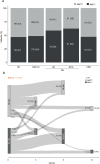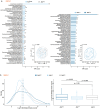Surrogate markers of intestinal dysfunction associated with survival in advanced cancers
- PMID: 40189749
- PMCID: PMC11980478
- DOI: 10.1080/2162402X.2025.2484880
Surrogate markers of intestinal dysfunction associated with survival in advanced cancers
Abstract
Deviations in the diversity and composition of the gut microbiota are called "gut dysbiosis". They have been linked to various chronic diseases including cancers and resistance to immunotherapy. Stool shotgun based-metagenomics informs on the ecological composition of the gut microbiota and the prevalence of homeostatic bacteria such as Akkermansia muciniphila (Akk), while determination of the serum addressin MAdCAM-1 instructs on endothelial gut barrier dysfunction. Here we examined patient survival during chemo-immuno-therapy in 955 cancer patients across four independent cohorts of non-small cell lung (NSCLC), genitourinary (GU) and colorectal (CRC) cancers, according to hallmarks of gut dysbiosis. We show that Akk prevalence represents a stable and favorable phenotype in NSCLC and CRC cancer patients. Over-dominance of Akk above the healthy threshold was observed in dismal prognosis in NSCLC and GU and mirrored an immunosuppressive gut ecosystem and excessive intestinal epithelial exfoliation in NSCLC. In CRC, the combination of a lack of Akk and low sMAdCAM-1 levels identified a subset comprising 28% of patients with reduced survival, independent of the immunoscore. We conclude that gut dysbiosis hallmarks deserve integration within the diagnosis toolbox in oncological practice.
Keywords: Akkermansia; Gut dysbiosis; MAdCAM-1; biomarker; chemotherapy; colorectal cancer; genitourinary cancers; immune checkpoint inhibitors; lung cancer.
Conflict of interest statement
L.Z. is founder of everImmune and its SAB President. L.D. is an everImmune SAB member. Contracts from Kaleido, 9 meters/Innovate Pharma, Pileje: L.Z. Research grant/ Fees from Fondation Roche; Roche, MSD, BMS, aAstra Zeneca: G.Z is a consultant for Da Volterra & Inventiva. P.D. had consulting roles and ran clinical trials for AstraZeneca, Bristol-Myers Squibb, Boehringer Ingelheim, Celgene, Daiichi Sankyo, Eli Lilly, Merck, Novartis, Pfizer, prIME Oncology, Peer CME, Roche, MedImmune, Sanofi-Aventis, Taiho Pharma, Novocure, and Samsung. M.F. was supported by the Seerave Foundation. C.C. reported personal fees and research grants from Amgen, Bayer, Merck Serono, MSD, Nordic Pharma, Roche, Pierre Fabre, Servier, Seagen, Tempus and Takeda. F.B. received institutional interest from AbbVie, ACEA, Amgen, Astra Zeneca, Bayer, Bristol-Myers Squibb, Boehringer Ingelheim, EISAI, Eli Lilly Oncology, F. Hoffmann–La Roche Ltd, Genentech, Ipsen, Ignyta, Innate Pharma, Loxo, Novartis, MedImmune, Merck, Mirati, MSD, Pierre Fabre, Pfizer, Sanofi-Aventis, and Takeda. A.S. is an investigator in phases I, II & III clinical trials sponsored by Amphera, Astra-Zeneca, BMS, MSD, Regeneron, Roche, Trizell L.B. received speakers’ fees from AstraZeneca, Merck Sharp & Dohme, and Roche, and travel fees from Takeda. B.B. participates to Advisory Boards: Abbvie, Biontech SE, BristolMyerSqibb, Chugai pharmaceutical, CureVac AG, Daiichi Sankyo, F. Hoffmann-La Roche Ltd, Pharmamar, Regeneron, Sanofi aventis, Turning Point Therapeutics; Conseil: Eli Lilly, Ellipses pharma Ltd, Genmab, Immunocore, Janssen, MSD, Ose Immunotherapeutics, Owkin, Taiho oncology; Steering committee: Astrazeneca, Beigene, GENMAB A/S, GlaxoSmithKline, Pharmamar, Roche-Genentech, Sanofi, Takeda.
Figures






References
-
- Sha D, Jin Z, Budczies J, Kluck K, Stenzinger A, Sinicrope FA. Tumor mutational burden as a predictive biomarker in solid tumors. Cancer Discov. 2020;10(12):1808–12. doi: 10.1158/2159-8290.CD-20-0522. - DOI - PMC - PubMed
-
- Baltussen JC, Welters MJP, Verdegaal EME, Kapiteijn E, Schrader AMR, Slingerland M, Liefers G-J, van der Burg SH, Portielje JEA, de Glas NA. Predictive biomarkers for outcomes of immune checkpoint inhibitors (ICIs) in melanoma: a systematic review. Cancers (Basel). 2021;13(24):6366. doi: 10.3390/cancers13246366. - DOI - PMC - PubMed
MeSH terms
Supplementary concepts
Grants and funding
LinkOut - more resources
Full Text Sources
Medical
